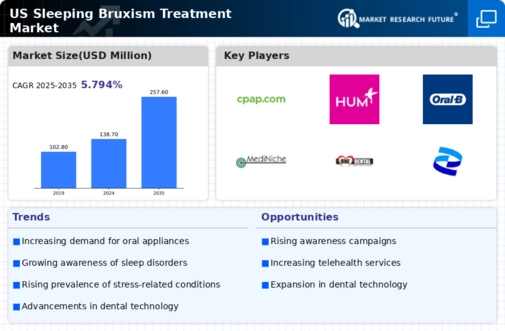The US Sleeping Bruxism Treatment Market is witnessing significant growth due to the increasing awareness about dental health and the associated disorders stemming from bruxism. As individuals become more cognizant of the health risks linked to teeth grinding, demand for effective treatment options is on the rise. This market largely comprises dental devices, medications, and behavioral therapies, with various stakeholders actively participating to address the needs of those suffering from bruxism.
Many companies are focusing on innovative solutions to cater to the growing patient population and improve treatment outcomes. Competitive insights reveal that the market is characterized by a mix of established players and new entrants, each striving to enhance their product portfolios and expand their market presence through strategic collaborations and technological advancements.
In the context of the US Sleeping Bruxism Treatment Market, Sleep Number Corporation has carved out a strong niche by promoting specialized sleep products designed to improve overall sleep quality, which is paramount for individuals suffering from bruxism. The company's strengths lie in its ability to integrate advanced technology into sleep solutions, including adjustable mattresses and sleep tracking systems that help users identify sleep issues that can exacerbate grinding behavior.
With a robust distribution network across the United States, Sleep Number Corporation effectively reaches its target audience by offering customized solutions that appeal to consumers seeking relief from sleep disturbances linked to bruxism. Their commitment to innovation and quality enhances their competitive edge in this specialized market.GlaxoSmithKline, a key player in the US Sleeping Bruxism Treatment Market, has established a substantial presence through its line of oral health products that target the symptoms associated with bruxism.
The company develops and markets a range of medications aimed at alleviating the discomfort caused by teeth grinding, focusing on pharmacological solutions as well as behavioral therapies. GlaxoSmithKline's strengths include a well-established research and development pipeline and strategic mergers and acquisitions that have strengthened its portfolio and market position within the US. The company aims to leverage its extensive sales and distribution networks to reach healthcare providers and consumers effectively.
By continually enhancing its offerings and incorporating user feedback into product development, GlaxoSmithKline maintains a competitive edge while adapting to the evolving landscape of the bruxism treatment market in the United States.






















Leave a Comment